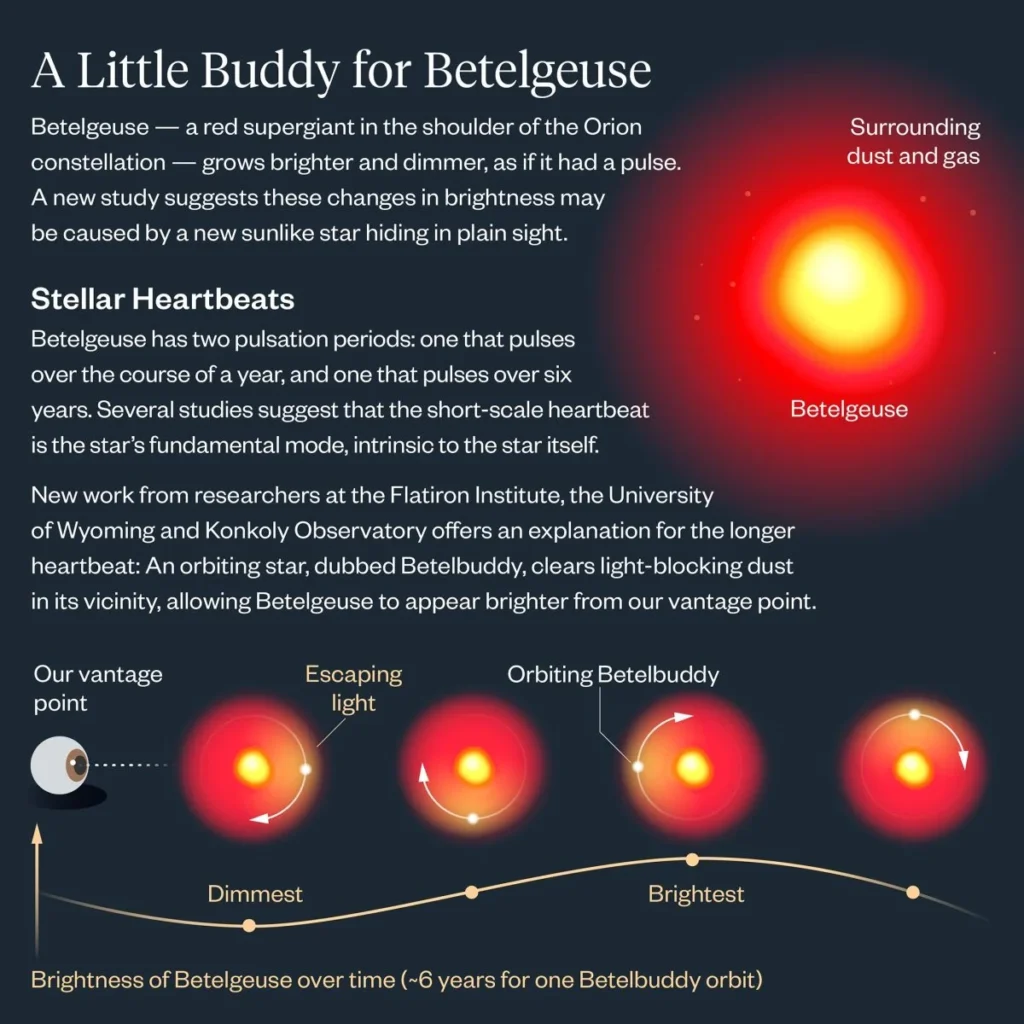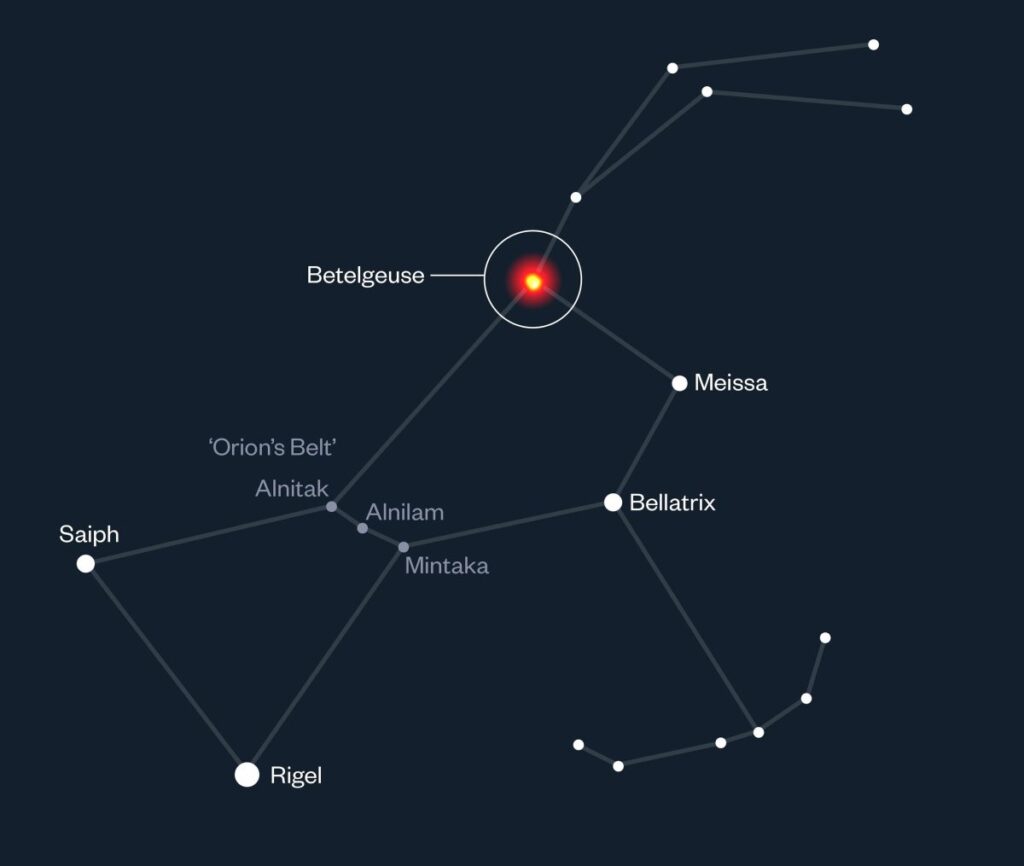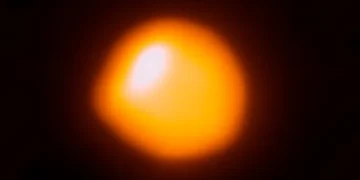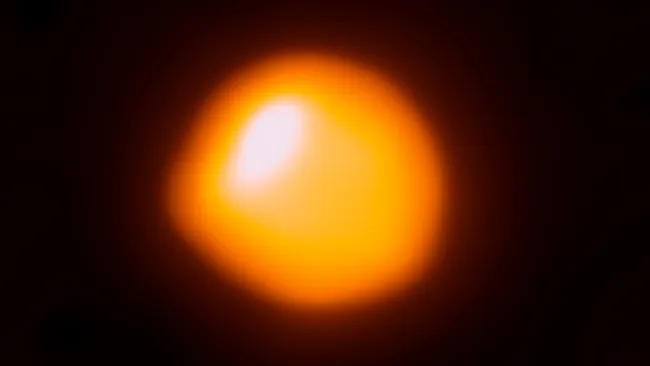Betelgeuse, a red supergiant star, has long intrigued astronomers with its fluctuating brightness, once thought to signal an imminent supernova. However, new research reveals a different story—its variations are likely influenced by a hidden companion star, nicknamed the “Betelbuddy.” This unseen partner clears cosmic dust, altering how Betelgeuse’s light reaches Earth and causing its irregular brightening.
Betelgeuse’s Brightness Mystery Explained
Betelgeuse’s variability is not a new observation. Historically, its periodic dimming and brightening cycles have captivated astronomers. These cycles, likened to a heartbeat, had some predicting an imminent supernova. Yet, new data suggest a different cause—one that might extend Betelgeuse’s lifetime and alter our understanding of stellar life cycles. The findings challenge past theories, showing that what we once thought was an internal process might be influenced by an external cosmic companion.
Discovery of the “Betelbuddy” Companion Star
Astrophysicists from the Flatiron Institute have proposed that a companion star, called Alpha Ori B or more colloquially, the “Betelbuddy,” orbits Betelgeuse and impacts its visible light. As this star moves through space, it behaves like a cosmic snowplow, pushing away the dust that obscures Betelgeuse’s glow from our perspective on Earth. By doing so, it can make Betelgeuse appear brighter when the dust is cleared, and dimmer when more dust settles.

This hypothesis emerged after ruling out other potential causes of Betelgeuse’s long-period variability, such as changes in its internal magnetic fields or intrinsic pulsations. According to Jared Goldberg, lead author of the study, the companion star theory was the only one that aligned with the observed data. This explanation is significant because it shifts the focus from Betelgeuse’s internal dynamics to its relationship with a neighboring star.
Why This Discovery is Important
The implications of discovering a companion star go beyond just understanding Betelgeuse’s brightness fluctuations. It challenges prior models that predicted a more immediate supernova and opens up new avenues for studying how massive stars interact with their surroundings. Betelgeuse is known for its size—more than 400 million times the volume of our Sun—and this research suggests that its behavior could be typical of other aging red supergiants.
The concept of a “long secondary period” in variable stars has puzzled scientists for decades. The long-term fluctuations in brightness that Betelgeuse displays have often been attributed to unknown internal mechanisms. The possibility of a companion star introduces a new perspective, suggesting that many red supergiants might have hidden companions influencing their light. This has broader implications for studying the life cycles of other similar stars.
The Role of Cosmic Dust and the Companion’s Impact
Cosmic dust plays a crucial role in how we perceive distant stars. Betelgeuse produces significant amounts of dust as it sheds outer layers in its final stages of life. This dust can block and scatter light, making the star appear dimmer. However, the Betelbuddy’s gravitational influence disrupts this dust, temporarily creating clearer paths through which more light can travel. This interaction explains why Betelgeuse’s brightness changes without the star itself necessarily becoming more active or nearing its explosive end.

The study’s simulations showed how this process unfolds, offering a detailed picture of the interplay between Betelgeuse and its companion. According to co-author Meridith Joyce, the team used advanced computer models to replicate the star’s environment and test various scenarios. By combining these models with direct observations, they were able to conclude that the Betelbuddy is the most likely explanation.
Future Research and Direct Observations
The next steps for the research team involve direct observation attempts to capture the Betelbuddy using high-resolution telescopes. This will be crucial in confirming the companion’s presence, as the current conclusions are based on indirect evidence. Around early December, there may be a window of opportunity to observe the companion more closely, potentially providing the first visual confirmation of this hidden star.
Further investigation is also needed to determine the Betelbuddy’s nature. While it could be a sun-like star, some speculate it might be a neutron star—an extremely dense remnant of a supernova explosion. The team hopes to explore these possibilities through X-ray observations, which could reveal signs of a neutron star’s influence. However, no such evidence has been found yet, keeping the mystery alive.
Changing the Supernova Timeline
One of the most significant impacts of this discovery is the adjustment it brings to predictions about Betelgeuse’s lifespan. If Betelgeuse’s brightness changes are due to an external companion rather than an internal buildup to a supernova, the star may have more time left than previously thought. This means that while a supernova remains inevitable, it might not occur as soon as some have predicted, allowing astronomers more time to study Betelgeuse before it meets its spectacular end.
This extended timeline is critical for understanding the life cycle of massive stars. Red supergiants like Betelgeuse are among the last stages in the evolution of stars before they explode as supernovae. Studying them provides valuable data on the processes that lead up to these cosmic explosions, offering clues about the origins of elements in the universe and the forces shaping galaxies.
Implications for the Study of Binary Systems
The discovery of the Betelbuddy also sheds light on the complexity of binary star systems—systems where two stars orbit around a common center of mass. Many stars, particularly massive ones, are believed to form as part of binary systems, but the interactions between such stars remain poorly understood. Betelgeuse and its companion provide a unique case study of how such systems can influence the evolution and visibility of their stars.
Understanding these interactions could have implications beyond Betelgeuse. It may help astronomers identify similar pairs among other variable stars and reconsider how they interpret brightness variations in stars that might have hidden companions. As more powerful telescopes like the James Webb Space Telescope continue to provide detailed observations of the universe, the knowledge gained from Betelgeuse could serve as a blueprint for decoding the behavior of other distant stars.
A New Chapter in Betelgeuse’s Story
The story of Betelgeuse has captivated stargazers for centuries, from ancient observers mapping its place in the constellation Orion to modern astronomers tracking its unusual behavior. The discovery of the Betelbuddy adds a new chapter to this story, shifting the focus from internal stellar processes to the hidden dynamics of star systems.
As Jared Goldberg and his team continue their research, Betelgeuse reminds us that even the most studied stars can hold secrets. It stands as a testament to the importance of curiosity-driven research and the potential for new discoveries, even in well-trodden areas of astronomy. The presence of a companion star reshapes our understanding of Betelgeuse’s fate, offering a more intricate picture of one of the night sky’s most famous stars.
Conclusion
The discovery of a potential companion star to Betelgeuse marks a turning point in our understanding of this red supergiant. It challenges long-standing assumptions about the star’s imminent supernova, suggesting instead a complex interplay between Betelgeuse and the hidden Betelbuddy. As scientists continue to explore this relationship, they open the door to new insights into the life cycles of massive stars, the role of binary systems, and the cosmic dust that shapes our view of the universe. For astronomers and enthusiasts alike, Betelgeuse’s story is far from over, promising more revelations in the years to come.
Reference:
“A Buddy for Betelgeuse: Binarity as the Origin of the Long Secondary Period in α Orionis” by Jared A. Goldberg, Meridith Joyce and László Molnár









![Gamma-ray burst [GRB]. Credit: Cruz Dewilde/ NASA SWIFT.](https://nasaspacenews.com/wp-content/uploads/2025/05/gamma-ray-burst-credit-nasa-swift-cruz-dewilde-1-75x75.jpg)









